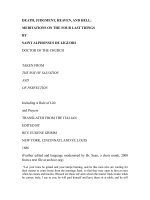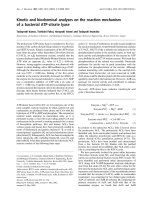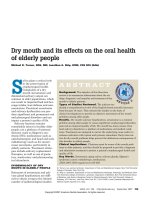Reporting investing and financing results on the balance sheet
Bạn đang xem bản rút gọn của tài liệu. Xem và tải ngay bản đầy đủ của tài liệu tại đây (715.76 KB, 50 trang )
McGraw-Hill/Irwin
Copyright © 2011 by The McGraw-Hill Companies, Inc. All rights reserved.
Chapter 2
Reporting Investing and Financing
Results on the Balance Sheet
PowerPoint Authors:
Susan Coomer Galbreath, Ph.D., CPA
Charles W. Caldwell, D.B.A., CMA
Jon A. Booker, Ph.D., CPA, CIA
Fred Phillips, Ph.D., CA
Learning Objective 1
Identify financial effects of
common financing and
investing activities.
2-3
Building a Balance Sheet
Assets
resources presently owned by a
business that generate future
economic benefit.
=
Liabilities
amounts presently owed by a
business to creditors.
+
Stockholders’
Equity
2-4
the amount invested and
reinvested in a company by its
shareholders.
Financing and Investing Activities
Assets
Companies rely on
Invest
inofAssets
two
sources
financing:
=
2-5
Liabilities
Debt Financing
+
&
Stockholders’
Equity
Equity Financing
Financing and Investing Activities
Key Features
2-6
Your Goals
1. A company always documents
its activities.
Picture each activity.
2. A company always receives
something and gives something.
Name the items.
3. A dollar amount is determined
for each exchange.
Analyze the effects.
Transactions and Other Activities
2-7
Learning Objective 2
Apply transaction analysis to
financing and investing
transactions.
2-8
Study the Accounting Methods
A systematic accounting process is used to
capture and report the financial effects of a
company’s transactions.
1 Analyze
2 Record
3 Summarize
A transaction is a business activity that affects the
basic accounting equation.
2-9
Duality of Effects
A = L+ SE
Every transaction has at least
two effects on the basic
accounting equation.
Assets must equal liabilities
plus stockholders’ equity for
every accounting transaction.
Step 1: Analyze Transactions
The chart of accounts is tailored to each company’s
business, so although some account titles are common
across all companies (Cash, Accounts Payable) others
may be used only by that particular company (Cookware).
Depending on the company, you may see a liability for a
bank loan called a Note Payable or a Loan Payable.
2-10
Step 1: Analyze Transactions
(a) Issue Stock to Owners.
Mauricio Rosa incorporates Pizza Aroma Inc., on August 1. The company issues
stock to Mauricio and his wife as evidence of their contribution of $50,000 cash,
which is deposited in the company’s bank account.
1. Pizza Aroma receives $50,000 Cash.
2. Pizza Aroma gives $50,000 Stock (Contributed Capital ).
2-11
Step 1: Analyze Transactions
(b) Investment in Equipment.
Pizza Aroma pays $42,000 cash to buy restaurant booths and other equipment.
1. Pizza Aroma receives $42,000 of Equipment.
2. Pizza Aroma gives $42,000 Cash.
2-12
Step 1: Analyze Transactions
(c) Obtain Loan from Bank.
Pizza Aroma borrows $20,000 from a bank depositing those funds in its bank
account and signing a formal agreement to repay the loan in two years.
1. Pizza Aroma receives $20,000 Cash.
2. Pizza Aroma gives a note, payable to the bank for $20,000.
2-13
Step 1: Analyze Transactions
(d) Investment in Equipment.
Pizza Aroma purchases $18,000 in pizza ovens and other restaurant
equipment, paying $16,000 in cash and giving an informal promise to pay
$2,000 at the end of the month.
1. Pizza Aroma receives $18,000 in equipment (pizza ovens).
2. Pizza Aroma gives a Cash of $16,000 and Accounts
Payable of $2,000.
2-14
Step 1: Analyze Transactions
(e) Order Cookware.
Pizza Aroma orders $630 of pans, dishes, and other cookware.
None have been received yet.
1. An exchange of only promises is not a transaction.
2. This does not affect the accounting equation.
2-15
Step 1: Analyze Transactions
(f) Pay Suppliers.
Pizza Aroma pays $2,000 to the equipment supplier from
transaction (d).
1. Pizza Aroma gives cash to settle its debt to the supplier.
2. Pizza Aroma receives a release from its promise to pay.
2-16
Step 1: Analyze Transactions
(g) Receive Cookware.
Pizza Aroma receives $630 of the cookware ordered in (e) and
promises to pay for it next month.
1. Pizza Aroma receives cookware with a cost of $630.
2. Pizza Aroma gave a promise to pay $630 on account.
2-17
Learning Objective 3
Use journal entries and
T-accounts to show how
transactions affect the balance
sheet.
2-18
Step 2 and 3: Record and Summarize
Most companies use computerized accounting systems, which
can handle a large number of transactions. These systems
follow a cycle, called the accounting cycle, which is repeated
day-after-day, month-after-month, and year-after-year.
2-19
The Debit/Credit Framework
ASSETS
=
Asset accounts
increase on the left or
debit side and
decrease on the right
or credit side.
2-20
LIABILITIES
+
STOCKHOLDERS’ EQUITY
Liability accounts
increase on the right
or credit side and
decrease on the left or
debit side.
Stockholders’ equity
accounts increase on the
right or credit side and
decrease on the left or
debit side.
Steps 2 & 3: Record and Summarize
1 Analyze
2 Record
3
2-21
Summarize
Steps 2 & 3: Record and Summarize
1 Analyze
2 Record
3
2-22
Summarize
Steps 2 & 3: Record and Summarize
1 Analyze
2 Record
3
2-23
Summarize
Steps 2 & 3: Record and Summarize
1 Analyze
2 Record
3
2-24
Summarize
Pizza Aroma’s Accounting Records
(a) Issue Stock to Owners.
Mauricio Rosa incorporates Pizza Aroma Inc., on August 1. The company issues
stock to Mauricio and his wife as evidence of their contribution of $50,000 cash,
which is deposited in the company’s bank account.
1 Analyze
2 Record
3
2-25
Summarize





![Privacy, Economics, and Price Discrimination on the Internet [Extended Abstract] pptx](https://media.store123doc.com/images/document/14/rc/pd/medium_pdp1394115652.jpg)



